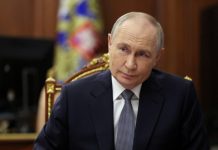
As Russian propaganda and disinformation spread around the world, more and more initiatives are being created to expose the lies and distortions emanating from the Kremlin: projects to expose fake news, analytical centres that review and monitor disinformation campaigns, and many private initiatives to observe Russian media. However, experts increasingly acknowledge that despite all these efforts, Kremlin propaganda remains a very effective tool of information warfare – much more effective than its Soviet predecessor.
In many respects, this difference is explained by the fact that, unlike Communist propaganda, today’s Kremlin’s ‘information operations’ do not need to adhere to a specific ideology. Modern Russian propaganda, unlike Marxism-Leninism, does not have to maintain logical consistency, and is in fact often internally contradictory. To create and maintain momentum, it uses images and the feelings created by images which are so provocative that they affect people much more than rational arguments. Russian propaganda does not create a system of views, but it appeals directly to emotions, instincts, reflexes and passions, the intertwining of which leads to the desired result for the Kremlin.
The problem in combating this disinformation is that it is almost impossible to argue with emotions. A coherent system of views can be refuted, ideological errors can easily be debunked by comparing them with the truth. But emotions are another matter. They flatter the human subconscious, respond to people’s deep instincts, immerse them in a world that is convenient and comfortable for them and can cause addiction, in some ways reminiscent of narcotics. People who are immersed in these emotions and inspired by propaganda images often simply do not want to know the truth, not wanting to go beyond their own imaginary world into the realm of dry and uncomfortable rationality. It’s interesting that propaganda used by populists and extremists in Europe and the United States by plays to similar emotions and instincts and uses similar images. Let’s try to highlight what these emotions are and how they are being used.
1. Fear
Certainly top of the list. In the case of Russia, the feeling of an extraordinarily high level of external threat has been and continues to be created. Propaganda convinces the audience that the country is surrounded by enemies eager for its complete destruction. The strongest image here is the image of future catastrophe – chaos and looting in the streets, poverty, bombs falling from above, dead children, and destroyed houses. A major element in this are videosdistributed on social networks, in which the United States is presented as a source of absolute evil and a sponsor of world terrorism. Their goal is not only to create an image of the enemy, but also to show that the US threat to Russia is unavoidable.
Through television, viewers are artificially plunged into an illusory hell, where the only way out is to consolidate around a national leader. It cannot be said that in this case base human instincts are being exploited – rather, these are natural defensive reactions. In Europe and the US, right-wing propaganda also actively uses a sense of fear: fear of immigrants, fear of women’s emancipation, and for the older generation, fear of communists and even moderate socialists whose victory in their minds is associated with the imminent collapse of society.
2. Hatred
This emotion follows naturally from the previous one. Scaring people is impossible without creating an image of the enemy – the source of the very threat that gives rise to a sense of fear. It is important to note that the enemy is created from those who are already viewed as enemies by most people or a certain group of people, and who give embody their greatest phobias. Everything the propagandists are fighting is blamed on these enemies and is firmly attached to their image and associated phobias.
As far as Russia is concerned, many Russians feel resentment towards Ukrainians because their ‘younger brothers’ chose another path, independent of Russia, preferring to orient themselves toward the West and thereby “betraying” Moscow. Hostility towards America has remained alive in Russia since the Cold War, and nowadays compensates for the sense of inferiority that Russian citizens feel when faced with American superiority in the development of technology, science, globally successful cinema and living standards. Sexual and religious minorities, anarchists and other movements, as well as the intelligentsia, have always been marginal and small in number in Russia, and therefore do not evoke sympathy among the broader population. That is why minorities (Muslims, Crimean Tatars, the opposition, etc.) are accused of terrorism; Ukrainians of committing “sabotage” in occupied Crimea; Americans, in particular the CIA, of paying people to participate in protest rallies, and so on. In the United States and Europe, objects of hatred vary depending on the social group at which propaganda is directed. For the anarchists, the state is declared as the source of all ills, for the nationalists, it’s the “Jewish conspiracy”, for the deeply religious, the image of the ‘liberal Antichrist’. At the same time, the blame placed on a certain group for the real or imagined problems more often than not has no basis in reality. However, it so impresses the target groups that they are ready to adhere to the worldview that is comfortable for them to the bitter end.
For example, extreme right-wing propaganda in the US, using the fear of communism, proclaims the investigation by the FBI and special prosecutor Mueller, as well as any rejection of Trump, as part of a “Communist conspiracy” designed to “destroy America.” The fact that Donald Trump is criticized by people with very different political views, many of whom do it solely for reasons of national security or the protection of key American values, is simply ignored by the creators of this illusory reality.
Hatred is especially dangerous because it removes moral prohibitions in those who are consumed by it. It justifies the most primitive and base human instincts: the desire to take part in collective persecution, to rummage in someone’s dirty laundry, to invade someone’s privacy, to turn someone’s life into a public spectacle. In Russia, this need is more than fulfilled by numerous exposés, most often created by the NTV channel: “Anatomy of the Protest”, “17 friends of the junta” and others like them, which are nothing more than public harassment and slander against people disliked by the regime. The ‘Putin majority’ eagerly awaits the next scandal and “sensational revelations” as a longed-for outlet in the general tedium of their lives. Propaganda gives them a much-needed respite – a “five minutes of hatred”, a rare opportunity to relax against the background of general pyschological mobilization and militaristic hysteria.
In the West, this hatred is expressed in the branding of immigrants as “animals,” the press as “enemies of the people,” and political opponents as “traitors”. The consequences of this are the proliferation of abusive memes, slanderous accusations against people conducting the investigation of collusion with Russia, in accusations of being “bought” by Clinton, Obama or George Soros. This includes numerous conspiracy theories about the “Deep State”, the natural consequence of which is the harassment and branding of even recognized heroes – for example, the recently deceased Senator John McCain.
3. Cynicism
This is an inevitable consequence of hatred and fear. The denigration and harassment of objects of hatred leads to their dehumanization, and more often the fight against such a “dehumanized” enemy is conducted on the principle that “the end justifies the means”. In Russia, one example of this phenomenon is so-called ‘artificial selection’, in which someone makes a career out of denunciations and harassment. Another aspect specific to Russian propaganda is a phenomenon that can be referred to as ‘ideological cynicism’. Those who are infected only partly believe, knowing full well that much of it is false. However, as long as they agree with the end, they can live with the lies and distortions that.
A state of war with the entire world is very convenient for these people, since it justifies the basest of their instincts. Their moral standards are extremely amorphous: they essentially do not believe in the possibility of the existence of democracy, fair elections, independent media, life governed by law and truth. At the same time, they believe that it is justified to lie, murder, seize foreign territory, create war, slander opponents and, in theory, wreak destruction around the entire world, since “it benefits us”. They believe in the benefits of such a behaviour with greater fanaticism than an exemplary Soviet citizen believed in the inviolability of Marxism-Leninism. The only difference is that instead of talking about the class struggle, these people, trying to appear to be experts, talk about ‘geopolitics‘ and about whose lives Russia finds it profitable to sacrifice to achieve their interests. Such reasoning gives them a sense of their own worth and justifies in their eyes any crimes and moral degradation.
In the United States, “ideological cynicism” is manifested in the fact that some of the radical right believe that even betrayal of national interests and collusion with a hostile state is an acceptable means of winning elections. Let’s recall the infamous T-shirts “I’d rather be Russian than a Democrat”, so highly appreciated by Russian propaganda media. At the same time, cynicism generates a special sense of superiority over enemies, who are seen as an annoying hindrance which must be eliminated at any cost.
4. Elitism
This involves playing to collectivist or, on the contrary, individual “elitism”. Even though these two are seemingly opposite, they are based on the same psychological need – the desire of a person to feel part of something that is undoubtedly good. In the first case, this means being part of a large cohesive community, which is especially evident in Russia (“normal people who do not accept Ukrainian fascism”, “the patriotic majority”, “ordinary people”). In the second case, it’s feeling you are part of “the chosen” (genuine patriots who have withstood the onslaught of liberal rootlessness and are ready to endure privations for the sake of the motherland, real strategists who understand the subtleties of geopolitics, etc.). This is equally true for both Russians and the extreme right. It can also be seen among ‘useful idiots’ who believe they are more insightful than the masses and can bring you “the truth” because they can “see through government/MSM lies”.
The main feeling here is a sense of community and involvement, which is not in itself a negative, but is always skillfully used by totalitarian regimes.
All mixed up
But the worst aspect of this kind of propaganda is that all four types are very often intertwined in a person’s mind, and it’s difficult to untangle them. Propaganda creates a full range of emotions and mental states – from horror and panic to a sense of superiority over the whole world, from baseness to catharsis, from extreme selfishness to fanatical sacrifice. And all of these states are easily interchangeable depending on how a person is feeling in any given moment, and how they justify and rationalize each of these feelings.
Reality is simply unable to withstand the competition from gaudily painted illusion, as many people choose to believe what they want to believe. The propaganda of the 21st century has proven that playing to images and feelings is more effective than any ideology and that controlling emotions is much more effective than controlling thinking.
It has also shown how surprisingly easy it is to persuade many people to drop their moral standards.
Kseniya Kirillova, for Integrity Initiative




